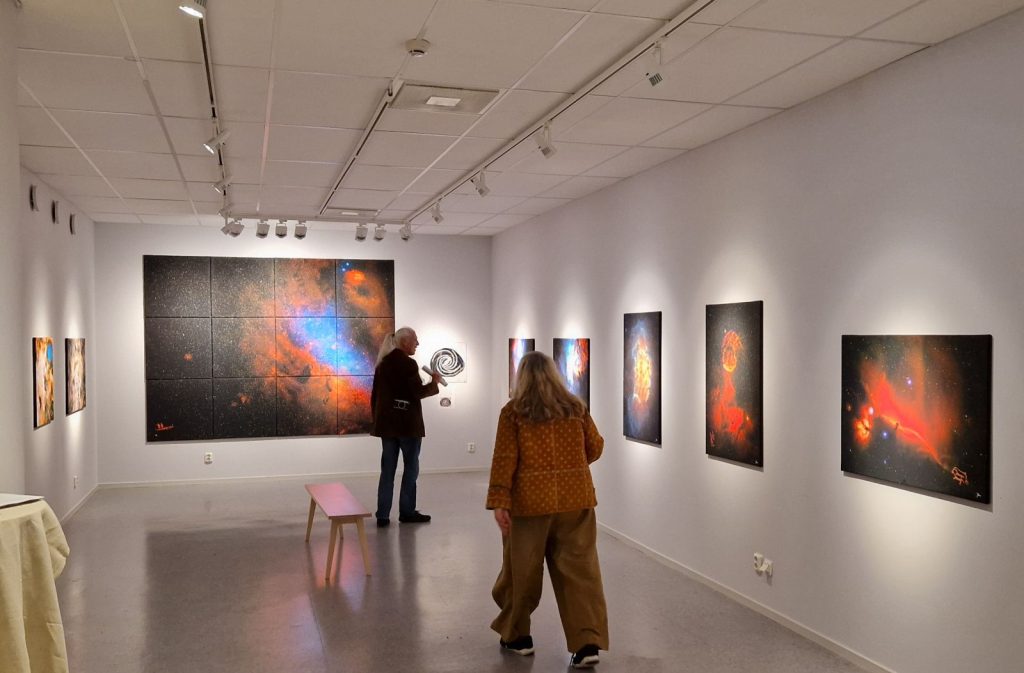With exceptional timing, this morning I took the girls up Mount Trosa and through the woods. The timing was decidedly perfect given the extremely windy conditions and, shortly after we walked in the door, the sudden downpour which would have drenched the three of us. It was even better given we just missed a falling tree.

A man out jogging stopped on the other side and reported it to the kommun.
Unfortunately, the tree where we turn off the path, in order to head down to the back gate, is the one just beyond the blockage. We managed to climb up the side and around, though it was a tad awkward for me.
And this wasn’t the only case of fallen tree I encountered today. There were fallen trees on the scenic route to Oxelösund, causing Nicoline to slalom through a few times.
We were off to Oxelösund in order to visit an exhibition by Jan Zettergren who plays around with stars, cosmology and ancient artefacts to create beautifully orchestrated images. That’s my description, by the way.
In Jan’s own words, his goal “is to give a sense of distance and time“. He highlights “the almost infinite time that light has travelled from distant galaxies and nebulae to reach Earth. The goal is to try to reconcile these eons of time with our own history and the Earth’s geology.”

We met Jan last year at Nicoline’s Not a Garden Party to which he wore a kilt. I told Nicoline that I rather fancied wearing a kilt, and she asked why I didn’t. I said I felt a fraud when I’m not in the least bit Scottish. She then said that Jan isn’t either, but it didn’t seem to bother him. Good point, well made, I thought.
But, back at the exhibition, Jan gave me a lesson in astronomy, sprinkled with the way he manipulated digital stacks of images in order to remove the stars and bring out the imagery hidden by their excessive light. The process is called astrophotography stacking. For the detail, Sky at Night Magazine has a useful article here.
Jan also adds colour and highlights certain areas of the images in order to give the final photograph greater depth and definition. He then puts some stars back.
The other thing he does is to insert objects that humankind was creating at around the time the light was produced. I’m not sure if that is especially effective, but it’s an interesting concept, nevertheless.
He has a website here where he explains his approach and thinking in more detail than I can include here. It’s worth it for the images, if nothing else.
We (Nicoline, Kalle and I) had a lovely short while visiting Oxelösund. Kalle was wearing his very scary Halloween mask, running around frightening people, Nicoline spent a short while talking to someone who didn’t really want to talk to her and I took full advantage of Oxelösund’s maritime history to take a photo of an anchor.

In the main entrance stairwell of the library (where the exhibition was held) there was, hanging from the ceiling, a big wooden anchor. I don’t think I’ve ever seen a wooden anchor before. I’m thinking it wouldn’t last too long. The big old iron ones, like the one pictured above, were surely better.
I should mention that no photographic manipulation was involved in the image. No, it’s just a beautiful old anchor.
Anyway, back at the house, scary Kalle gave the girls Halloween treats, as Nicoline had suggested yesterday. It worked fine, as he offered them little bits of cat kibble from the palm of his hands. His laughter was a delight and the girls were very pleased.
All round, an excellent day.



That approach to astro art sounds fascinating
And why didn’t they want to talk to Nicoline??
Glad the tree missed you! 🌲😊
The exhibition looks really interesting! ✨ 🌟